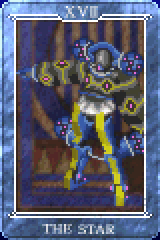| ASTRIA |
 |
|||||
| Quote: |
“I am the mapper of the stars, Astria. Stars change, but they also show one’s fate. Know that your way is before you.” | |||||
| Card: | Star |
Level: | 62 | Mythos: |
Greek |
|
| Level-up: |
+1 Agility |
SP: |
38 | Unknown Power: | Recovery | |
| Cards to Summon: |
248 + "Ortyx" |
Return for: |
Me Patra card | Modification: |
none |
|
| Element: | Wind affinity. Immune to
Wind and Holy, reflects Mind, Vulnerable to Earth |
|||||
| Spells: | Garudyne Alluring Mazurka Dream Needle Me Patra Twinkle Nebula De Kaja |
Rank 1 Rank 3 Rank 5 Rank 6 Rank 8 (mutation) |
||||
| Notes: |
The Material Card
"Ortyx" is found in one of the treasure rooms in the caves under Iwato
Mountain. As
there is only one Ortyx card, Astria can never be summoned again if she
is
returned in the Velvet Room. Astria's participation is required for the special mythos fusion Dragon Cross. |
|||||
In Greek myth, Astria and Leto were daughters of the titans Koios and Phoebe. Both sisters attracted Zeus's lust: Leto was willing, and she bore Zeus the twin children Apollo and Artemis. But centuries earlier, Astria had been less willing. Fleeing from "the struggling eagle’s clutch" (Ovid) she threw herself off a cliff into the ocean and was transformed into a partridge ("ortyx" in Greek). Her troubles were not over, as having escaped from the sky-god she was now pursued by his equally lustful brother the sea-god Poseidon. To escape him, she turned herself into a barren floating island, which did not rest in any one spot but fled continually over the surface of the ocean.
Callimachus says:
| ...no constraint afflicted thee, but free upon the open sea thou didst float; and thy name of old was Asterie, since like a star thou didst leap from heaven into the deep moat, fleeing wedlock with Zeus |
When Leto became pregnant by Zeus much later, his jealous wife Hera swore that there would be no safe resting place on earth for the expectant mother: all cities and lands refused her. Only the island of Delos, her transformed sister, braved Hera's wrath, rooting itself in the ocean floor to become for the first time solid land, a safe birthplace for the infants Apollo and Artemis.
The Roman poet Pindar wrote :
| Hail. O heaven-built isle, most lovely scion of
the
children of bright-haired Leto, O daughter of the sea, thou unmoved
marvel of the spacious earth, by mortal men called Delos, but by the
blessed gods of Olympos known as the far-seen star [astra] of the
dark-blue earth … For aforetime, that isle was tossed on the waves by all manner of whirling winds; but, when Leto, the daughter of Koios, in the frenzy of her imminent pangs of travail, set foot on her, then it was that four lofty pillars rose from the roots of earth, and on their capitals held up the rock with their adamantine bases. There it was that she gave birth to and beheld her blessed offspring. |
However, there is another side to Astria's story.
There are parallels between the story of Astria (Ulala's ultimate persona) and that of her first persona, Callisto.
